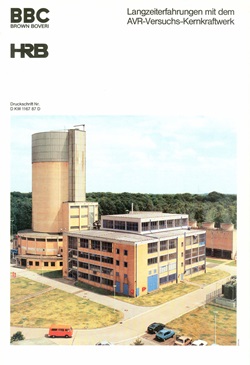| The reactor bankruptcy - THTR 300 | The THTR Circular |
| Studies on THTR and much more. | The THTR breakdown list |
| The HTR research | The THTR incident in the 'Spiegel' |
The THTR Circulars from 2012
***
| 2023 | 2022 | 2021 | 2020 | ||
| 2019 | 2018 | 2017 | 2016 | 2015 | 2014 |
| 2013 | 2012 | 2011 | 2010 | 2009 | 2008 |
| 2007 | 2006 | 2005 | 2004 | 2003 | 2002 |
***
THTR Circular No. 140, Dec. 2012
Content:
Criticism of LANUV measurements of the beads at the THTR
What does the NRW Ministry of the Environment say about the THTR beads?
THTR - friends kiss each other
Nonviolent against nuclear power plants in India
Criticism of LANUV measurements of the beads at the THTR:
Crucial measuring ranges have been left out!
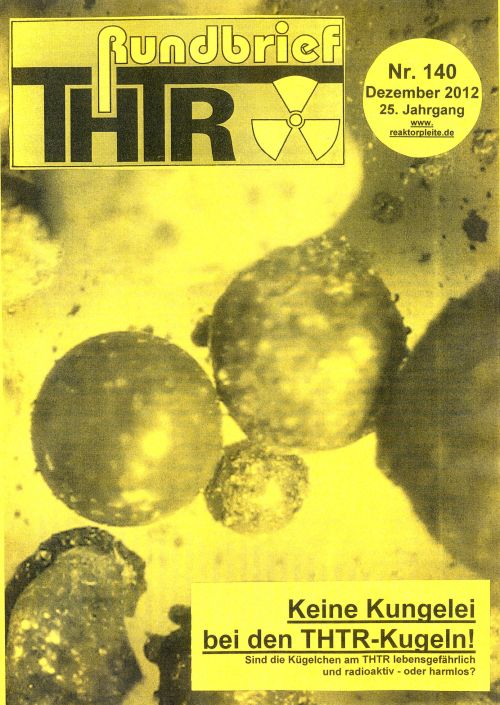
The history:
In 1986, eight days after the reactor disaster in Chernobyl, an accident occurred in the thorium high-temperature reactor (THTR) in Hamm, in which radioactivity was released. Destroyed fuel element balls containing tens of thousands of 0,4 mm PAC balls (plutonium, americium, curium) were blown out through the exhaust stack.
The measuring strips for radioactivity emissions at the THTR operator showed five empty spaces for a total of 150 minutes within these crucial hours.
In spring 2012, as part of "Jugend forscht", an eleven-year-old student discovered numerous tiny spheres in the vicinity of the THTR. These tiny spheres were passed on to the LIA - NRW State Institute for Work Design - and a little later to the LANUV - State Office for Nature, Environment and Consumer Protection NRW - for analysis. The two investigations came to the conclusion that there is no radioactivity in the beads and that the samples submitted may be iron oxide particles.
In the meantime, there has been clear criticism of the research methods. The consulted expert HW Gabriel, who worked on the THTR safety report decades ago, has already twice analyzed the beads found near the THTR. In connection with the numerous cases of leukemia near the nuclear facilities in Geesthacht, he found globules similar to those at THTR a few years ago.
Gabriel criticizes the fact that in the LANUV publication exactly those measuring ranges were omitted that were involved in the investigation of the thorium reactor: Thorium and other specific radioactive substances of the THTR!
The criticism in detail:
The report of the LANUV "Analysis of spherical substances in soils of Hamm" published on July 06.07.2012th, XNUMX raises some fundamental questions that urgently need to be clarified.
The LANUV claims to have carried out a total element determination with the help of X-ray fluorescence analysis and scanning electron microscopy (SEM). As a result, it is claimed that the submitted sample is only iron oxide particles that do not contain any other chemical elements with a high atomic number (such as thorium, uranium, plutonium).
According to the expert HW Gabriel, the LANUV report is to be criticized for several reasons:
What is striking about the gamma spectrometry values published by the LANUV is that the measurement range for thorium (93 keV = emission energy) is hidden because the LANUV report only shows the measurement range from a value greater than 100 keV. Even if it is considered that the spectrum of all secondary products of thorium in the range greater than 100 keV is often used as a "fingerprint" for substances with an emission energy lower than 100 keV, the entire measurement protocol with all measurement ranges should be made public.
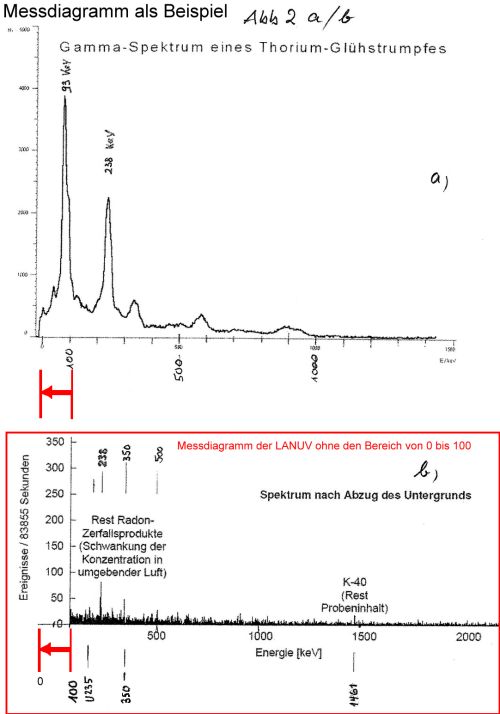
Another point of criticism is that the LANUV only measured a sample mass of approx. 1 gram for a single day. In view of the explosive nature of the globule finds, this is insufficient. Even with the rudimentary LANUV publication, radioactive particles are recorded in the diagram in the gamma spectrum of the thorium progeny, lead (PB 212)! No absence of radioactivity and nuclear fuel can therefore be derived from the published measurement results.
For X-ray fluorescence analysis:
For the purpose of element determination, only a sample section (!) Up to an energy of 5 keV is shown in the illustration of the LANUV (page 4, Fig. 11). For the investigation of the relevant nuclear fuels Th, uranium and plutonium, however, 12,8, 15,6, 16,2 and 18,97 keV are to be settled. Here, too, the essential information on precisely those substances that are relevant for the investigation is missing.
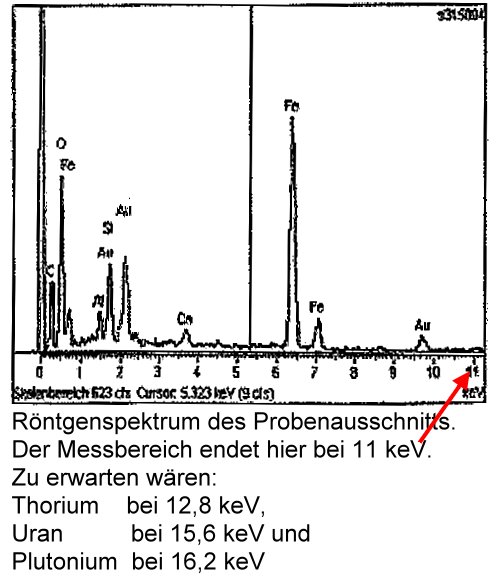
If the two areas mentioned above were actually not measured, this should definitely be done. If so, what speaks against publishing the whole "yardstick" of the results?
Conclusion
In the last few years, the citizens' initiative for environmental protection in Hamm has been approached again and again by concerned people from the area surrounding the THTR because of the accumulation of cancer cases. A child cancer study (KiKK study) requested by the BI and 2008 citizens in 4000 did not take place at the THTR, although all other nuclear power stations in Germany were examined! The unprecedented series of breakdowns and accidents in the THTR and their possibly harmful consequences for tens of thousands of people make it imperative to examine the tiny spheres that have been found comprehensively and not just in detail.
That is why BI environmental protection Hamm demands:
- Publication of the entire measurement results!
- New measurements with a targeted analysis of THTR-typical substances!
- Carrying out a cancer study in the vicinity of the THTR!
Further information:
ZDF film "And nobody knows why: leukemia death in the Elbmarsch" from 2011: http://www.youtube.com/watch?v=H53C2yA9z4Q
What does the NRW Ministry of the Environment say about the THTR beads? |
To find out, we wrote a letter on December 6, 2012 with questions and demands to the green environment minister of North Rhine-Westphalia, Johannes Remmel:
In the last few years, the citizens' initiative for environmental protection in Hamm has been approached again and again by concerned people from the area surrounding the THTR because of the accumulation of cancer cases. Due to various newspaper articles about tiny spheres that were found in the context of "Jugend Forscht", citizens who suffered from cancer or leukemia have again contacted us.
Despite the previously published investigations by LIA and LANUV, a new report by HW Gabriel (formerly co-author of the THTR safety report) has resulted in a whole series of inconsistencies and questions that should definitely be investigated.
On July 9, 7, the LIA wrote to the Hamm Environment Agency: "In coordination with MAIS as the client, the full report was published on the LIA.NRW website, so I cannot provide you with any further expertise."
After HW Gabriel published doubts about these investigations in the Westfälisches Anzeiger on November 1st (public holiday, All Saints' Day), the LIA published a completely new, expanded version on Monday, November 5th, within just a few hours of official work over the weekend of the report. This is astonishing because the LIA previously wrote that the “complete report has already been published on the LIA.NRW website” and allegedly no further information could be given. We hope that you will respond quickly this time as well.
1.) For the gamma spectral analysis of the LIA
("Gamma spectrum of the sample, the empty chamber and the spectrum obtained by subtraction"; LIA homepage: Measurement of "spheres" in Hamm-Uentrop with additions from October 30.10.2012, 6). Mr. HW Gabriel comments as follows in his report (see Gabriel report, pages 7 - XNUMX):
a.) In the middle graphic "Background of the empty measuring chamber" a Pb-212 peak is mentioned. But: This is not 238 keV, but clearly visible on the scale at 200 keV! The empty measuring chamber therefore does not contain any thorium secondary product. Its secondary product cannot fluctuate and cannot be withdrawn from position 1 ("bowl with globules") and thus cannot reduce the radioactive measured values in the end result!
b.) In the graphic below (“spectrum after subtracting the background”) the Pb-212 peak at 238 keV is again very clear. However, it is explained by the LIA with the following argument: "Fluctuation of the concentration in the surrounding air". - This argument is wrong, because in the thorium series the radon-220 in question, with its short half-life of 55 seconds, cannot escape from materials within this short time in order to cause fluctuations in indoor air activity (!).
c.) If one also takes into account the range around 3 to 60 keV and the recognizable lines of Ac 70 in the third graphic below ("spectrum after subtracting the background"), the LIA has the proof of the presence of thorium in its measurements provided in the soil sample. However, it did not mention this in the interpretation of the measurement results. With a longer measurement time (more than just 228 day) and a smaller distance between the sample and the detector, the evidential value would increase.
d.) In order to be able to analyze and evaluate the measurement results of the LIA more precisely, it is necessary that not only the diagrams that have already been processed, but especially the raw data recorded in log files with the precisely specified energy ranges (keV) and counts are published. We therefore demand the publication of the raw data of the measurement results.
2.) The nature of the THTR fuel element balls.
Mr. HW Gabriel writes in his report (pages 2 and 3): "The USA has banned the supply of highly enriched uranium since 1977. Scientists found a substitute for U-235 by using micro-spheres (Pu 3 - 30 micrometers, other heavy metals up to 50 micrometers in diameter) with fissile transuran (Pu, Am, Cm) using the ICF process. (...) In contrast to the black coatet particles (cp 0,4 mm) made of Th-U mixed oxide, one group appears of PAC hollow spheres / ellipsoids white, another black.
They do not have the mechanical strength of coated particles. If the thin spherical shell is broken open, the tiny spheres can be seen as bright points concentrated inside and scattered in the outside area. (...) The structure of the tiny spheres can be seen under the electron microscope: They are made up of platelets / sintered and look like a football made of leather patches. "
If these statements by Mr. Gabriel were correct, the THTR Hamm not only used highly enriched uranium (HEU) as fuel, but also another thorium-TRU mixture. - Is this statement from Gabriel true?
3.) For X-ray fluorescence analysis of the LANUV:
On page 7, Mr. HW Gabriel complained about the investigation of the LANUV that only the outer shell of the hollow spheres was measured. The very small nuclear fuel spheres embedded in these hollow spheres cannot be measured with this method.
4. a) How does the Ministry rate HW Gabriel's statements under the points outlined above?
b.) We request that further investigations be commissioned in the following areas:
- More precise gamma spectral analysis (extended measurement time to approx. 3 days, smaller distance between sample and detector) with subsequent re-evaluation of the measured values and evaluation.
- Exact investigation of the nature and the radioactivity of the THTR fuel used under the aspect of whether the THTR fuel is possibly a thorium-TRU mixture. It may be necessary to take samples of balls from the castors in the BEZ Ahaus.
- A balancing of the supply and removal of the THTR fuel elements, broken down according to origin, quantity and composition. We ask for an opinion and an answer to our questions as soon as possible. The report from HW Gabriel is attached for your information.
THTR - friends ku (n) gel further: |
New funds for THTR research and cheap "disposal" of contaminated sites planned! The dismantling of the very small THTR in Jülich, which was shut down in 1988, causes huge costs with many hundreds of millions of euros and even greater problems and headaches. Because the nuclear facility is much more radioactively contaminated than previously assumed due to a number of incidents that have so far been neglected (1).
200.000 years after its shutdown, it is still unclear where the 24 tennis ball-sized radioactive fuel elements of this breakdown reactor are going. Nobody in the world wants to know anything about this reactor line today. Even the Chinese regime is no longer continuing. South Africa got a bloody nose and had to pay a billion euros hardship - for nothing and again for nothing. The nuclear phase-out in the FRG is a thing that has long been decided. After the shocking revelations by the insider Rainer Moormann (2), this reactor line is dead and forever discredited - one would think!
But none of this challenges a tiny group of unteachable, ultra-fanatic supporters of the pebble bed reactor in Jülich. They want to continue to earn money on the further development of the chaos reactor in a highly self-interested manner. You haven't learned anything else. The Aachener Zeitung of July 25, 7 reported:
"The Federal Government is supporting the new research on the outdated Jülich nuclear technology with around 500 euros, as the Federal Ministry of Economics reports on our newspaper's request. Title of the work:" Transport, deposition and resuspension of graphitic dust in a noble gas atmosphere at high temperatures ". The project is on In total, the answer from Berlin goes on to say that the house of Minister Philipp Rösler (FDP) is funding around 000 projects on reactor safety research within the scope of nuclear safety and repository research with a funding amount of around 110 million euros in the current year. "
It has always been the same at THTR for decades: Although this reactor line has run down and is allegedly no longer being pursued, huge sums of money have been invested in the further development of these Generation IV reactors under both black and yellow and red and green (!) Federal and state governments. The whole thing is declared by the beneficiaries of the lavish government subsidies as security research and, to top it all, as export subsidies. Even the red-green state government of North Rhine-Westphalia practiced this extensively (3)!
Four doctoral positions for scrap reactor research in NRW!
"Hans-Josef Allelein, holder of the RWTH Chair for Reactor Safety and Technology, who advertised the doctoral position, also brings up the argument of safety assessment. In an interview with our newspaper, however, he also says:" Here, insights have been gained that are useful for further developments can be of great benefit. "Of course, it is also about export opportunities. After all, in the last 30 years - especially at the height of Rudolf Schulten - two billion D-Marks have already been invested in the technology. And the nuclear phase-out? Do you have to develop high-temperature reactors in Germany if there will soon be no more nuclear power plants here? Allelein considers the question to be petty nation-state thinking: "A sustainable energy supply is of general global interest." (...) In total, explains Allelein, there are four PhD positions at RWTH in cooperation with FZJ, which deal with the high-temperature reactor. One of them is funded by the Federal Ministry of Economics. The other three are co-financed by the State of North Rhine-Westphalia, simply because it provides the universities with funds - although the current government is against such research "(4).
Cheap disposal in the USA planned!
In order to be able to continue the illegal research on the THTR line in peace and quiet, the AVR pebble bed reactor must of course not make too negative headlines and the "disposal" of its extensive radioactive nuclear waste must be at least superficial. And which bunny is best to conjure up from the top hat in such a case? - Right! The nuclear waste is shipped to the other end of the world, so it is practically "gone". The research center is even completely selflessly and responsibly creating a lot of peace by putting an end to the evil, evil proliferation of nuclear weapons-grade material - of all things by sending it to the USA. The atomic friends' almost ingenious move can be read as follows in the press release of the FZJ of July 6, 7:
"Forschungszentrum Jülich and its partners, the Federal Republic of Germany and the State of North Rhine-Westphalia, are currently working with the American Department of Energy (DOE) to examine the option of transporting the fuel elements back from the decommissioned AVR test reactor to the country of origin of the nuclear fuel, the USA.
The first discussions between the research center and the DOE have been positive. The federal government and the state of North Rhine-Westphalia support these discussions, especially since the transports that are necessary in this case no longer aim at further intermediate storage in Germany, but would lead to the permanent storage of the fuels in the country of origin. The DOE has shown itself to be open to accepting the AVR fuel elements from Jülich. This willingness is based on the US pursuing an active non-proliferation policy. This means that the US endeavors to return nuclear fuel from other countries that has been made available for research purposes to the US in order to permanently avoid any risk of further proliferation.
Now the USA is an imperialist state and neither peace-loving nor "responsible" nor selfless. In the USA there are currently two graphite reactors used by the military; radioactive graphite spheres can certainly be used there. In addition, there is a long tradition of risky tinkering with forerunners of the HTR line (5). The radioactive material may also be intended for this. Even if this material were "only" to be disposed of in the US, who is going to tell us that in a really safer way in the long term? And how "happy" will the local residents be? Once again very typical is the endeavor of the red-green and black-and-yellow governments alike to get rid of the problem of radioactive nuclear waste as simply and cheaply as possible. That way they can "rule through" much more easily.
Science Minister Svenja Schulze declared on behalf of the North Rhine-Westphalian state government:
"The state government welcomes the fact that a new solution option for the storage of the AVR fuel element balls is now on the table. The state of North Rhine-Westphalia and the federal government will jointly support the FZJ in pursuing this solution."
Since the storage permit for the THTR fuel element balls in Jülich expires in 2016, the irresponsible planned to bring these balls over 134 kilometers in 76 double castor transports by truck to Ahaus in order to store them there for an indefinite period of time. The NRW citizens' initiatives protested violently against this plan for the past two years and encouraged the radioactive material to remain in Jülich because transports are very unsafe. For example, during the motorway action days, attention was drawn to the potentially dangerous consequences of transport through densely populated areas. The NRW initiatives will undoubtedly have to make an effort to make clear in the future the entire dimension of the risk of many nuclear waste transports (by air?) Across half the globe, which has now been increased many times over.
Notes:
1. See THTR newsletter No. 138
2. See THTR newsletter No. 136
3. See THTR circular no. 80, 83, 89, 92, 96, 107
4. Aachener Zeitung from July 25, 7
5. "Fort St. Vrain, the HTR forerunner in the USA" in http://www.reaktorpleite.de/fort-st-vrain-der-htr-vorlaeufer.html
Post Comment: On November 14, 2012, the Supervisory Board of Forschungszentrum Jülich decided to suspend the application for the transport of the castors with the fuel elements to Ahaus in the BEZ. A temporary location for an interim storage facility in Jülich is now to be sought.
Nonviolent against nuclear power plants in India |
Brutal repression against fishing villages in the south of India who are resisting the government's nuclear power plant construction plans
A year ago, under the heading “Church supports hunger strike against nuclear power plant in India”, one could read the following remarkable report about the Kolping India (Kolping India) active for many decades on “Domradio” in Cologne: “In South India the Catholic Church supports one Hunger strike against a nuclear power plant. According to Indian media reports, a total of 127 people, including 15 Hindus and 112 Catholics, have been on hunger strike against the Koodankulam nuclear power plant in the state of Tamil Nadu for nine days. Among them are four priests and three nuns. 15 people must already be The fisheries director of the diocese of Tuticorin and leader of the strike, Father Rayappan, told the Catholic News Agency (KNA) that safety standards had not been met during the construction of the nuclear power plant. (1)
As early as 2004, hundreds of families in 58 Kolping villages in the vicinity of the controversial Kudankulam nuclear power station were suffering from the terrible consequences of the tsunami, and in the following years they received help from friendly partner organizations in Germany.
Government is planning eight new nuclear power plants!
Here in South India of all places, right by the sea, eight nuclear power plants are now planned; two are almost ready for use. There is no question that the population, especially the fishermen, are very worried. You have seen what can happen in Fukushima with a nuclear power plant close to the sea.
As in Wyhl, where the feared cloud development from cooling towers could also affect the harvest of the winegrowers, in southern India there were in some cases no special nuclear concerns that spurred the resistance. The water drained from the nuclear power plants will raise the sea temperature and put fishermen's fishing grounds at risk.
If tens of thousands are now resisting, as in Kudankulam, then this inevitably calls for the "Friends of the Masses" who are holding an "International Conference in Support of the People's War in India" in Hamburg in November and the "unsuspecting" lectures that have been active for decades send: "It is not primarily about an abstract 'environmental protection' as demanded by bourgeois movements, but primarily about the protection of the working masses, the people" (2).
The history
India needs a lot of energy to go "successfully" on the capitalist-industrialist path. That is why the expansion of atomic energy was pushed ahead and close cooperation was agreed with the former Soviet Union since 1988.
An additional agreement followed in 1998 that provided for the construction of two Russian WWER pressurized water reactors, each with a capacity of 1.000 MW, in Kudankulam in Tamil Nadu (3).
In 2000, the ongoing strategic partnership was sealed by the heads of government and the intention was announced to let Russia build a total of 18 nuclear power plants in India (4). In 2002, construction began on the first two nuclear power plants in Kudankulam. The reactors were constructed in St. Petersburg and brought to southern India by sea.
"The operating organization Nuclear Power Corporation Ltd. (NPCIL) is a public company controlled by the DAE (Department of Atomic Energy). It was founded in 1987 and is based in Mumbai." (5) It is noticeable that the nuclear industry emphasized early on to promote social activities, infrastructure and even wind turbines in the surrounding communities. One of the largest wind farms in India with an output of 2.000 MW is now in operation in Kudankulam right next to and on the nuclear power plant site.
For the Kudankulan 3 and 4 power plant blocks, Russia and India laid down a road map for further cooperation (6). In July 2012, Russia agreed on an export credit of 3,4 billion dollars with a term of 14 years for these follow-up projects (7).
It will be very difficult for the nonviolent resistance movement against these nuclear power plants to assert itself against ratified contracts of important international partners, strategic national self-interests and industrial growth mania.
Water for humans or nuclear power?
From 2006 onwards, violent disputes took place in Tamil Nadu over the water use of the Pechiparai Dam, which is more than a hundred years old. The lake, about 60 kilometers away from Kudamkulam, served as a drinking water reservoir and irrigated the farmers' fields. According to the government's will, this water source should in future mainly serve to cool the new nuclear power plants and no longer meet the needs of the local population (8).
The hearing took place at the end of a long argument right on the nuclear power plant site. But before this date, the Indian Prime Minister signed the contracts for the construction of four nuclear power plants in Kudankulam. The whole event was a farce. So the movement had its experiences with politics very early on, which was only conducive to its clear-sighted actions in the following period.
Police terrorize fishing villages
After the opponents of the nuclear power plant received little attention from the media for years, this changed significantly after the disaster in Fukushima. As a first highlight, thousands of residents and affected fishermen blocked the access roads to the nuclear power plant construction site in autumn 2011. A temporary hunger strike of 10.000 people and an open-ended hunger strike of 127 people added and increased the pressure dramatically. The operators had to interrupt the commissioning preparations for the first reactor block for 6 months. The commissioning, which had been delayed for years, dragged on again.
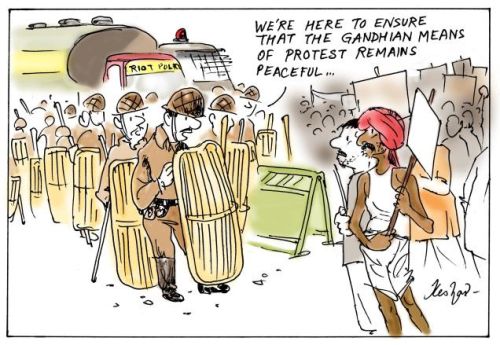
When work resumed in March 2012, 20.000 people demonstrated in front of the reactor site; another hunger strike followed. The government imposed a curfew and sent 6.000 police officers from the Rapid Action Force to Kudankulam and terrorized the local population. Since Christians are also involved in the resistance and in the organization "People's Movement Against Nuclear Energy" (PMANE) and a Christian church serves as a meeting point, Hindu nationalists are deliberately stoking prejudices by accusing them of "betraying" the national cause.
This is intended to provoke religious riots against the Christian minority and to sideline PMANE. However, the population structure in this region is more similar to the neighboring state of Kerala, where Hindus, Christians and Muslims have been roughly equally represented for centuries and have lived together peacefully and tolerantly.
The government also accuses foreign environmentalists and non-governmental organizations of providing the opponents of the nuclear power plant with personal and financial support and has initiated punitive measures. How little the Indian government actually has in hand was shown by the fact that only a completely uninvolved German long-term holidaymaker was deported. The only foreigners involved in this conflict are Russian engineers on the operator side.
Only 7 euros fine for offenses by the nuclear power plant operators While the Indian government and the nuclear power plant operators are trying to enforce their interests by militarizing an entire region, the state nuclear supervision is completely overwhelmed and powerless to enforce minimum safety standards.
As reported by "Der Spiegel" (9), the Indian nuclear supervisory authority AERB can only demand a fine of 7,46 euros for serious violations of safety regulations in nuclear power plants! - No, no zeros are missing here; they sit in the Indian government.
After further hunger strikes and large-scale demonstrations in May 2012, the situation on site escalated again when the permit to start up the first reactor was granted in August. A fisherman was shot dead by the police during a demonstration on September 9th.
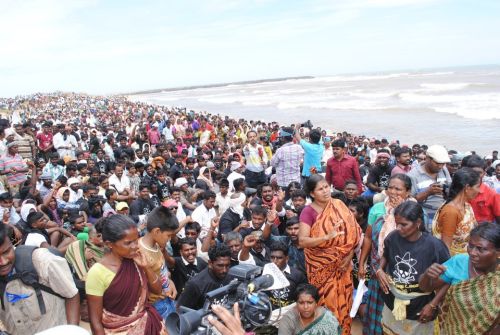
Shortly afterwards, 20.000 people besieged the access roads to the nuclear power plant construction sites. The police brutally attacked the non-violent demonstrators with batons and tear gas grenades. Since then, this police operation has been hotly debated across India. Former naval chief Admiral L. Ramdas called for a moratorium. The writer Arundhati Roy publicly criticized the quasi-military state of emergency in the region and the police vandalism that even took place in fishermen's houses (10).
Spectacular sea blockades
On September 21st, the "sea blockade" of the nuclear power plants began with 500 fishing boats, self-made wooden buoys and human chains in the water. In the countryside, harassed by a brutal police presence, this time the fishermen practiced their creative resistance on their very own "terrain".
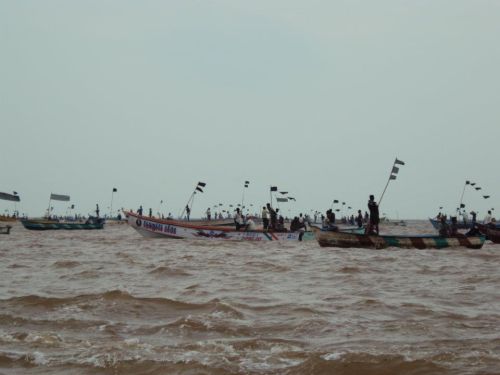
The impressive pictures were broadcast on many television channels in India and can also be viewed on YouTube in Germany. It was a clever move by the non-violent resistance movement to at least partially avoid the military force on land and now to block supplier ports and nuclear power plants from the sea.
On October 8, 2012, Kudankulam was again besieged from the sea by 800 fishing boats. They came within 500 meters of the nuclear power plant. The Coast Guard deployed 10 police boats to keep protesters at bay in the shallow waters. Ten kilometers further a "Jal Satyagara", a human chain in the water, was carried out in Koothakuzhi in solidarity (11). The nonviolent activists have undertaken further actions over the next few weeks to bring the protest to the capital of Tamil Nadu, Chennai (formerly Madras).
The courageous fishermen of Kudankulam have a seemingly overpowering opponent. But even at the beginning of the 19th century, imperial Great Britain would not have thought that it would soon have to leave rebellious India. Why shouldn't the nuclear colonizers fare the same?
On September 29, 2012 there was a first protest rally in front of the Indian consulate in Frankfurt. It would certainly be helpful if there were protests in front of Indian institutions or, for example, at German-Indian events such as the "Days of India 2012-2013" in Europe. The international solidarity of the anti-nuclear power movement is required here.
And the hundreds of Kolping groups in the FRG should also show that they can not only organize charitable aid for tsunami victims, but also politically and practically support a well-founded non-violent protest by their partner organization in India.
Notes:
(1) From September 20, 9: www.domradio.de/news/artikel_76535.html
(2) http://indiensolidaritaet.wordpress.com/2012/10/01/flugblatt-solidaritat-mit-den-kampfen-gegen-atomkraft-in-indien/#more-423.
(3) www.nuklearforum.ch/de/aktuell/e-bulletin/haben-russische-exportfinanzierung-fuer-kudankulam
(4) atw (nuclear industry), issue 1/2011, page 52
(5) atw, issue 5/2007, page 350
(6) atw, issue 4/2010, page 284
(7) See Note No. 3
(8) Nuclear Monitor, Amsterdam, No. 652, 2007
(9) Spiegel Online from August 23.8.2012, XNUMX
(10) From: www.firstpost.com/india/kudankulam-live-if-govt-cant-handle-garbage-how-will-it-handle-nuclear-waste-452361.html
(11) From: www.dnaindia.com/india/report_anti-nuke-activists-lay-siege-to-kudankulam-plant-from-sea_1750168
More info: www.dianuke.org
Post Comment:
This article first appeared in the monthly Grassroots Revolution. Journal for a Nonviolent, Dominant Society “No. 373 (November 2012). - In the meantime, a large demonstration and other actions have taken place in the state capital of Chennai (Madras), which is almost 700 kilometers away. A human rights commission that came by bus was arrested for eight days and a mirror editor was arrested. Internationally and across India, numerous organizations and well-known personalities (A. Roy, N. Chomsky) have shown solidarity with the resistance.
Dear Readers!
Of course, I am well aware that some pages, especially in this issue, are relatively difficult to read because the focus is on the scientific analysis of the consequences of the THTR accident. But where else than in the "Fachblatt" THTR-Rundbrief should it be reported in detail? The outcome of the discussion about the globules found at the THTR is quite open.
At least five people took part in the formulation of the questions to the NRW Ministry of the Environment. As a citizens' initiative, we aim to involve as many people as possible in decision-making and political work.
This means that as many people as possible have access to important information, even if the texts are sometimes not that easy to understand straight away. It is therefore a question of not leaving the field for vital decisions to "experts" in governments and corporations alone. We want to anchor and practice grassroots democracy in as many areas of society as possible. This requires a lot of power from below.
At this point I would like to take the opportunity to refer to my new homepage, in which I mainly (but not exclusively) make articles from the "pre-Internet era" since the 70s available again. There are articles on culture and politics, ecology and parliamentarism, trade unions and the media, international and local issues from Hamm.
For example, if you enter the name Masannek, the cause of the greatest scandal in Hammer's post-war history, on Google today, you will find almost only the "wild guys" of your son, a contemporary article and a pathetic ten lines in the HammWiki, which is almost overflowing with trivialities. - But recently also an article from 1986 that I wrote in the green NRW regional newspaper on this subject. Here is the link: www.machtvonunten.de
Horst Blume
***
Top |
***
Donation appeal- The THTR-Rundbrief is published by 'BI Umwelt Hamm e. V. ' issued and financed by donations. - The THTR circular has meanwhile become a much-noticed information medium. However, there are ongoing costs due to the expansion of the website and the printing of additional information sheets. - The THTR circular researches and reports in detail. In order for us to be able to do that, we depend on donations. We are happy about every donation! Donations account:BI Umweltschutz Hamm |
***
Top |
***



